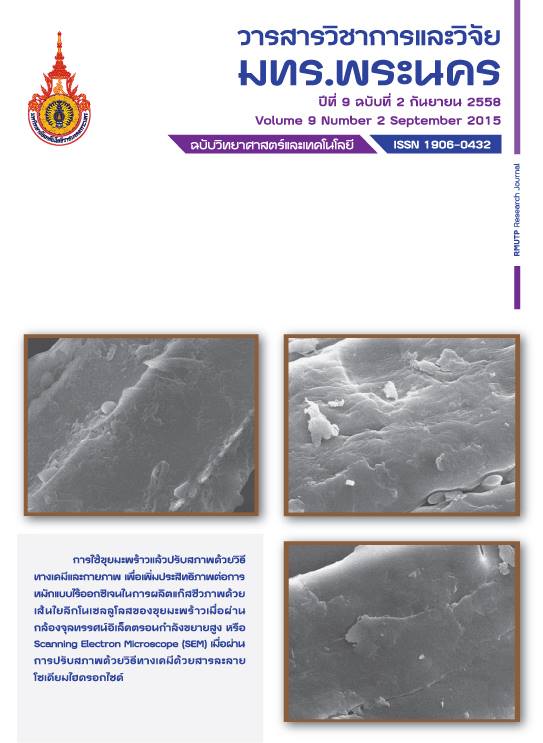การปรับสภาพขุยมะพร้าวเพื่อผลิตแก๊สชีวภาพโดยกระบวนการหมักแบบไม่ใช้ออกซิเจนร่วมกับมูลวัว
Main Article Content
บทคัดย่อ
บทคัดย่อ
การศึกษาสภาวะที่เหมาะสมในการปรับสภาพขุยมะพร้าวโดยวิธีการทางเคมีร่วมกับทางกายภาพเพื่อการผลิตแก๊สชีวภาพ โดยทำการเตรียมตัวอย่างขุยมะพร้าว นำไปอบแห้งและลดขนาด (ประมาณ 0.1 มิลลิเมตร) วิเคราะห์องค์ประกอบทางเคมีของตัวอย่างเริ่มต้นได้แก่ เซลลูโลส เฮมิเซลลูโลส และ ลิกนิน 35.67±2.02, 7.41±0.69 และ 40.82±0.62 โดยน้ำหนัก ตามลำดับ หลังจากที่ขุยมะพร้าวผ่านการปรับสภาพด้วยวิธีที่แตกต่างกัน 4 วิธี พบว่าการปรับสภาพด้วยสารละลายโซเดียมไฮดรอกไซด์ร้อยละ 30 โดยน้ำหนัก ให้องค์ประกอบทางเคมีสูงสุด คิดเป็นเซลลูโลส เฮมิเซลลูโลส และลิกนิน 43.30±0.35, 29.69±0.48, 27.36±0.03 โดยน้ำหนัก ตามลำดับ เมื่อเทียบกับตัวอย่างเริ่มต้น (p<0.05) หลังจากนั้นศึกษาศักยภาพการผลิตแก๊สชีวภาพร่วมกับมูลวัว ในอัตราส่วนต่างๆกัน (1:1 1:2 1:3 และ 1:4) เป็นเวลา 30 วัน พบว่าที่อัตราส่วน 1:4 มีปริมาณแก๊สชีวภาพสะสมสูงสุดเท่ากับ 442.6 มิลลิลิตร มีแก๊สมีเทนและแก๊สคาร์บอนไดออกไซด์เป็นองค์ประกอบอยู่ร้อยละ 46.1 และ 23.1 ร้อยละการกำจัด (% remove) ของปริมาณของแข็งทั้งหมด (TS) ของแข็งระเหยง่าย (VS) ของแข็งแขวนลอย (SS) และซีโอดี (COD) คิดเป็นร้อยละ 69.3 32.5 50.0 และ 58.4 ตามลำดับ อัตราส่วนคาร์บอนต่อไนโตรเจน เท่ากับ 23:1 ดังนั้นขุยมะพร้าวจึงเป็นอีกทางเลือกหนึ่งที่นำมาประยุกต์ใช้ในการผลิตแก๊สชีวภาพโดยประยุกต์ใช้ร่วมกับมูลวัว ซึ่งขุยมะพร้าวที่ผ่านการปรับสภาพจึงเป็นอีกทางเลือกหนึ่งในการผลิตแก๊สชีวภาพ อีกทั้งยังเป็นการนำวัสดุเหลือทิ้งทางการเกษตรมาประยุกต์ใช้เพื่อเกิดประโยชน์ในอนาคต
Abstract
The optimal pretreatment condition of coconut husk by physicochemical methods for biogas production was investigated. The coconut husk was dried and ground into powder (~0.1 nm) and was then determined for chemical contents such as cellulose, hemi-cellulose and lignin, respectively. The chemical contents of cellulose, hemi-cellulose and lignin were 35.67±2.02, 7.41±0.69 and 40.82±0.62 w/w, respectively. After pretreatment with 4 different methods, the results showed that the pretreatment of sodium hydroxide 30 % (w/w) gave the highest chemical contents of cellulose, hemi-cellulose and lignin with 43.30±0.03, 33.69±7.48 and 27.36±0.03 w/w, respectively. As for the biogas production, the result showed that the ratio of coconut husk to cow dung of 1:4 with C:N ratio of 23:1 gave the highest cumulative biogas of 442.6 ml for 30 days. Methane and carbon dioxide contents were 46.1 and 23.1 %. Moreover, the removal percentages of the total solids (TS), volatile solid (VS), suspended solids (SS) and COD were 69.3, 32.5, 50.0 and 58.4 %, respectively. The coconut husk could be used as an alternative material for the application of biogas production with cow dung in the near future.


